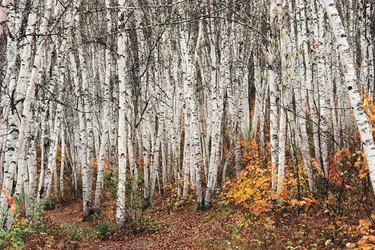
A walk into a forest reveals a dense canopy of leaves and numerous tall, vertical trunks. These same trees, if planted in the open expanse of a park lawn, do not become as tall and lanky. Instead, the trees grow wider and fuller because of ample sunlight. Plants also can affect how nearby companions grow, as roots tangle and compete for the same resources of water and nutrients in the soil. Planting too close together limits the growth potential and often threatens plant health.
Inadequate Spacing Increases Competition
Video of the Day
In order to prevent a situation where you end up with plants in competition with one another, ensure that the amount of spacing around each plant -- both soil and air -- is proportional to the plants' individual sizes. Plants that are small at maturity, such as a spinach or radish plant, do not need as much space in a garden compared to a large-growing oak or lilac shrub. Moreover, young plants need less space initially, and may be grown in closer proximity until their size dictates greater spacing. This rule is easily seen at greenhouse production facilities or at the plant nursery. Seedlings are grown in small containers in denser numbers than larger plants in bigger pots, such as tree saplings.
Video of the Day
Physical Effects of Overcrowding Plants

Plants that grow too close to each other compete for the same sunlight, water and soil nutrients. The first effect seen is competition for light. Overcrowded plants begin to grow upward to receive light, rather than developing a fuller, bushier silhouette. Eventually, only the most vigorous, light-receiving plants survive, as they end up shading the small, weaker neighbor plants. Likewise, as roots grow, more water and nutrients must be absorbed to sustain the above-ground growth. Closely spaced plants must develop a root matrix that mingles with the same seeking roots as the neighbor. Whichever plant is more vigorous reaps the most water and nutrients. However, with numerous plants and roots, the soil resources deplete more quickly, affecting all plants in the area. More irrigation and fertilizer is needed.
Consequences of Planting Too Close
Besides issues of plants in competition that arise from overcrowding, secondary problems occur. With close spacing and increased growth from competition, plants often are not exposed to wind and air, causing stem tissues to become weaker or be exposed to more humid conditions. Humidity can support fungal diseases. Weaker stems are more succulent and easier for insect pests to cut or suck sap from. The dense canopy of foliage from the overcrowded plants masks a gardener's view of any disease or pest problems lower on the plants or on the soil surface.
Overcrowded Plants Reduce Productivity

Plants sited too closely together ultimately do not produce as many leaves, flowers, cones/fruits or seeds as compared to plants that have light, air and lots of soil around them. Fewer branches reduces the locations where a plant may form a flower or fruit, which diminishes the entire capacity for ornamental flowers or harvest of a food crop such as apple, tomato or corn cob.